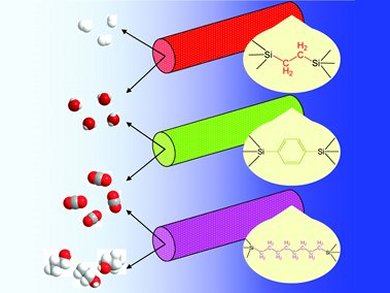Membrane-based separation is easy, energy-efficient and relatively cheap compared with distillation, for example. Large scale separation of gases and liquids has not been possible until now due to the limited stability of the membranes available.
Hessel Castricum and colleagues, University of Amsterdam, the Netherlands, have developed a versatile membrane that is capable of separating gas and liquid mixtures. It is made from a hybrid organically linked silica material which gives it exceptional stability. The team predicts that it could be used for many years at high, industrially relevant temperatures.
By varying the bridging link in the material, it was possible to tune the selectivity of the membrane to separate different size ranges of molecules (see picture). This tunability and its stability make it promising for industrial applications such as carbon capture and biofuel production.
Image: (c) Wiley-VCH
- Tailoring the Separation Behavior of Hybrid Organosilica Membranes by Adjusting the Structure of the Organic Bridging Group
H. L. Castricum, G. G. Paradis, M. C. Mittelmeijer-Hazeleger, R. Kreiter, J. F. Vente, J. E. ten Elshof,
Adv. Funct. Mater. 2011, 21(12), 2319—2329.
DOI: 10.1002/adfm.201002361




